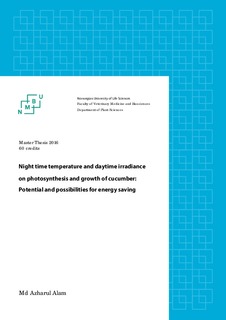| dc.contributor.author | Alam, Md Azharul | |
| dc.date.accessioned | 2016-04-04T12:44:08Z | |
| dc.date.available | 2016-04-04T12:44:08Z | |
| dc.date.issued | 2016-04-04 | |
| dc.identifier.uri | http://hdl.handle.net/11250/2383789 | |
| dc.description.abstract | Growth chamber experiments were conducted with seedless cucumber cv. Odeon to examine the effect of night temperature on photosynthesis and growth with compensation possibilities of daytime irradiance level. Further, the effects of night temperature and the level of daytime irradiance on carbohydrate composition in different plant parts were also assessed with high performance liquid chromatography (HPLC). Daily average temperature was mainly responsible for the growth of cucumber seedling by increasing the height, leaf number, total leaf area and total dry weight. It enhances the potential of lowering night temperature in combination with high day temperature. Lowering night temperature from 22 °C to 14 °C reduced almost 34% growth as dry matter production. As long as the daily mean temperature is equal, the split night temperature had no effect on daily net photosynthesis, height; leaf area and plant dry weight. Increasing level of irradiance increased the plant’s daily net photosynthesis and the magnitude of increment was significantly high at low night temperature than at high night temperature. At low night temperature (14 °C), net photosynthesis was doubled when light intensity was increased from 200 to 400 μmol m-2 s-1. This was reflected in the total dry weight of the plants as well. The dry matter production of cucumber seedling increased almost 30% at low night temperature (14 °C) and 7% at high night temperature (22 °C) when light intensity was doubled. This indicated the potential of irradiance on compensation of losses caused by low temperature although, it will be extra energy costs related to increased light level if that has to be done by artificial lighting. Carbohydrate profiling revealed that the total carbohydrate content was significantly affected by irradiance level than temperature. Total carbohydrate concentration was increased by 8% at low night temperature (14 °C) and 20% at high light intensity (400 μmol m-2 s-1). Among the different plant parts analyzed, the total carbohydrate content was significantly high in stem in all temperature and irradiance combinations. However, night temperature or daytime irradiance did not affect the proportion of total carbohydrate partitioned between plant parts. | nb_NO |
| dc.language.iso | eng | nb_NO |
| dc.publisher | Norwegian University of Life Sciences, Ås | |
| dc.title | Night time temperature and day time irradiance on photosynthesis and growth of cucumber: Potential and possibilities for energy saving | nb_NO |
| dc.type | Master thesis | nb_NO |
| dc.subject.nsi | VDP::Agriculture and fishery disciplines: 900::Agriculture disciplines: 910::Plant breeding, horticulture, plant protection, plant pathology: 911 | nb_NO |
| dc.source.pagenumber | 61 | nb_NO |
| dc.description.localcode | M-PV | nb_NO |
